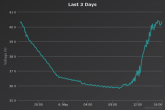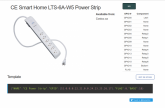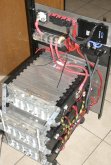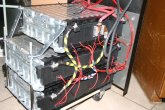I purchased 2 of the 10S 3P and 1 of the 8S 3P LG Chem Chevy Bolt packs from Battery Hookup as the cost per KWH was hard to beat.
All of the cell groups were well within .01 volt when I got them and they do look basically new.
So far I made up a mounting system to hold the packs in a 19 inch equipment rack.
I cut the middle buss bar of the 8S pack to split it into two 4S sections without physically separating the pack.
I made clamp on copper terminals with matching 6mm bolts.
I used #2 cables to wire each 10S pack in series with a 4S section to make two 14S strings.
I have each 14S string connected to a buss bar with 125 amp fuses.
I purchased a JKBMS with 2 amp active balancing and common port 200 amps protection switch.
I soldered wires to each cell junction and joined the 2 strings with fuses to the single BMS.
The JKBMS seems to be working great. It allows you to customize all of the parameters. I currently have the cell over voltage set to turn off at 4.2 volts and turn back on at 4.1 volts. The cell under volt turn off is set to 3.2 and the turn on at 3.3 volts. Full turn off if any cell goes below 3.0 volts.
I have the max charge current at 145 amps. With 6 cells in parallel, that is under 25 amps per cell, or less than 0.5 C rate. The max discharge is topped out at 200 amps, which is still well below the cell capability. It also has an internal temp sensor for the the protection FET's and balance circuits and then 2 remote sensors to mount on the batteries. The battery protection temps are also fully configurable. The battery bank will live in my garage in So Cal so low temperature won't be an issue, but it can exceed 110F here. I plan to extent the temp sensors and mount them where the battery get's the hottest.
I do not have my inverter/charger yet. My current plan is to use a Schneider XW-Pro. I would set it to limit the charge voltage to just 4.1 volts per cell, and the low battery shut down will also be set to about 3.5 volts so the BMS is only a secondary safety. This should stay well away from the BMS having to step in and shut it down. I do not have any load or charger here currently that can stress these batteries. I have pumped about 600 watts in and pulled nearly 1000 watts out and the cells seem rock solid with virtually no voltage dip and they stayed at just room temp. Once my system is up and running, it will mostly be used to do self consumption. Time shifting about 10 kwh from solar production to the 5 pm to 9 pm peak TOU charge time. But I will have my Enphase solar gear and my essential loads connected after the inverter so I will also be able to run most of my home during a power failure. Doing the rough math, I should be able to keep most of my home running off grid with all the sun we get here. Just can't run that A/C compressor.










